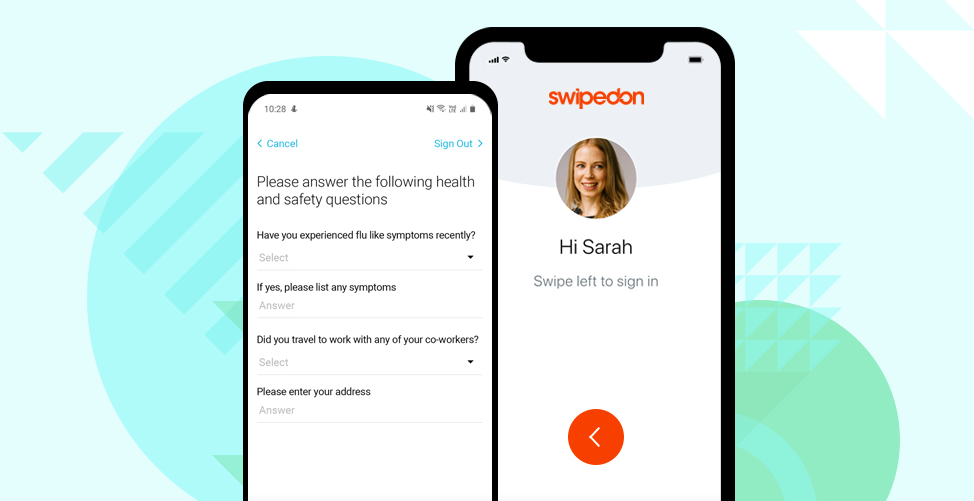Top 4 Questions to Ask in an Employee Health Screening

Employees who need to work out of physical locations are putting themselves at a much greater risk of contracting and spreading COVID-19 or the annual flu. As a preventative measure, the CDC recommends that businesses implement employee health screenings—a proven strategy for early detection, management, and prevention of outbreaks in the workplace.
SwipedOn has helped countless businesses reopen their offices safely and conduct health screenings through our visitor management system. As such, we understand that not all health screenings are effective and that asking the right questions is crucial to alerting you if a high-risk individual has entered your workplace. Below are the questions that businesses should be asking during a health screening to both comply with regulations and keep their workplace safe.
The Importance of Employee Health Screenings
Implementing health screenings can be a powerful tool for minimizing unnecessary onsite contact, reducing exposure from guests, and providing full visibility into the health and wellness of your organization. The adoption of health screenings has been grown in recent years along with the growing adoption of employee wellness programs. As of 2019, 88% of large employers had a wellness program or wellness incentives in place, with 32% offering incentivized health screenings. Since the start of 2020, those numbers have only grown.
Health screenings have evolved since the beginning of the COVID-19 pandemic, with many businesses implementing infrared thermal temperature checks, biometric tools like distancing wristbands, and even digital “immunity badges”. These measures are all aimed at helping businesses safely reopen, but can feel like an encroachment on personal privacy or yield inconsistent results.
Health screen questionnaires have become a preferred method in aiding contact tracing efforts since they allow individuals to self-assess their risk and are less invasive than other methods. Health screenings can also be easily implemented in your front desk area to screen employees and visitors as they enter your workplace. Ask yes/no questions to determine if they pose a risk to your business, instantly notify hosts of guest arrivals, and maintain accurate time-stamped records for visibility.
Health screenings are only as effective as the questions we choose to ask, however. To effectively understand and manage the risk posed to your business, consider adding the following questions to your health screening questionnaire.
1. Have You Had Any of the Following COVID-19 Symptoms in the Past Two Weeks?
This essential question has become a staple in employee and visitor health screenings. Per the CDC guidelines, individuals should self-evaluate before entering a building and check for these COVID-19 symptoms:
- Fever or chills
- Cough
- Shortness of breath or difficulty breathing
- Fatigue
- Muscle or body aches
- Headache
- Loss of taste or smell
- Sore throat
- Congestion or runny nose
- Nausea or vomiting
- Diarrhea
Additionally, an individual must not currently be under evaluation for COVID-19 (i.e. waiting for results from a COVID test or knowingly exposed in the last 14 days) and they must not have been diagnosed with COVID-19 in the last 14 days.
By asking these questions, employers can gauge a workplace’s risk of COVID-19 exposure. Employers should be considerate when asking health-related questions, however, as it would normally violate the Americans with Disabilities Act (ADA). During a pandemic, ADA-covered employers are granted access to ask employee pandemic-related symptoms and health questions.
When asking questions, employers should carefully phrase them. For example, to avoid confusion of common COVID-19 symptoms with other ailments, consider asking the question, “Can your symptoms be explained or are they related to any known condition that is not infectious?”
If any employee or guest signifies that they have experienced symptoms recently, ask them to identify their symptoms and immediately ask them to stay home. Identify who they have been in contact with and send all parties out of the workplace.
2. Do You Agree to the Company's COVID-19 Regulations?
Employers have also been using health screenings to help enforce healthy workplace practices. Once you’ve determined that an employee is healthy, the next step is to ensure they are taking steps to maintain a safe workplace environment. Notify guests of social distancing measures, cleaning procedures, mask expectations, and other procedures. If they don’t agree, they will not be welcome in the workplace. Digital visitor agreements can reinforce this expectation by including a signed agreement into the visitor management system (or you can print a PDF for the wall of your reception area).
By setting the precedent early, businesses can have peace of mind that each visitor and employee agrees with the measures being taken to maintain a safe and secure environment.
3. Have You Come in Contact with Anyone Who Has Displayed COVID-19 Symptoms or Has Had a Confirmed or Probable Case in the Past 14 Days?
It is essential to understand if individuals entering your workplace are at risk of becoming sick with COVID-19—or may even be asymptomatic. To assess their risk, employers should ask if staff or visitors have knowingly come in contact with anyone who may have been exposed to COVID-19.
The question can be expanded to provide greater insight. Consider asking instead, “Have you come in close contact (under 6 feet) with anyone confirmed or suspected of having COVID-19 in the last 14 days?”
To minimize the risk of exposure to asymptomatic carriers, businesses can ask questions regarding an individual's travel exposure, as well. Two more questions that allow employers to gauge the risk associated with asymptomatic carriers include:
- Have you traveled outside the country or to a COVID-19 hotspot in the past 14 days?
- Have you traveled to a site currently listed within a Level 3 Travel Health Notice or higher with the CDC in the past 14 days?
4. Is It Critical for You to Be On-Site or Can You Work Virtually?
Finally, businesses need to assess the necessity of having certain staff onsite at all during the pandemic. One of the best ways to follow CDC guidelines for healthy workplaces is to enforce social distancing by minimizing in-person exposure. Every time an employee or visitor enters your workplace, they are putting the rest of your workforce at risk. By determining if an employee’s onsite presence is necessary, employers can open up a conversation with employees about the best course of action for their particular job function. Employers can decide whether it is best for an employee to work remotely or if they are vital to being in the workplace.
It’s easier for employers to maintain safe reception areas, common areas, and meeting rooms when managing a reduced, and necessary, onsite staff. Employers should give careful consideration regarding whether an employee needs to come to work physically every day, or at all.
How a Visitor Management System Streamlines Employee Health Screenings
Including the right questions in your employee health screenings is crucial for minimizing COVID-19 risk exposure and maintaining a safe workplace. Screening questions not only keep your employees safe, but they also communicate thought-leadership to visitors and show you are taking the pandemic seriously. SwipedOn’s visitor management solution can seamlessly manage contactless employee health screenings to protect staff and workplaces from the risk of exposure to serious diseases.






 Germany - Deutsch
Germany - Deutsch